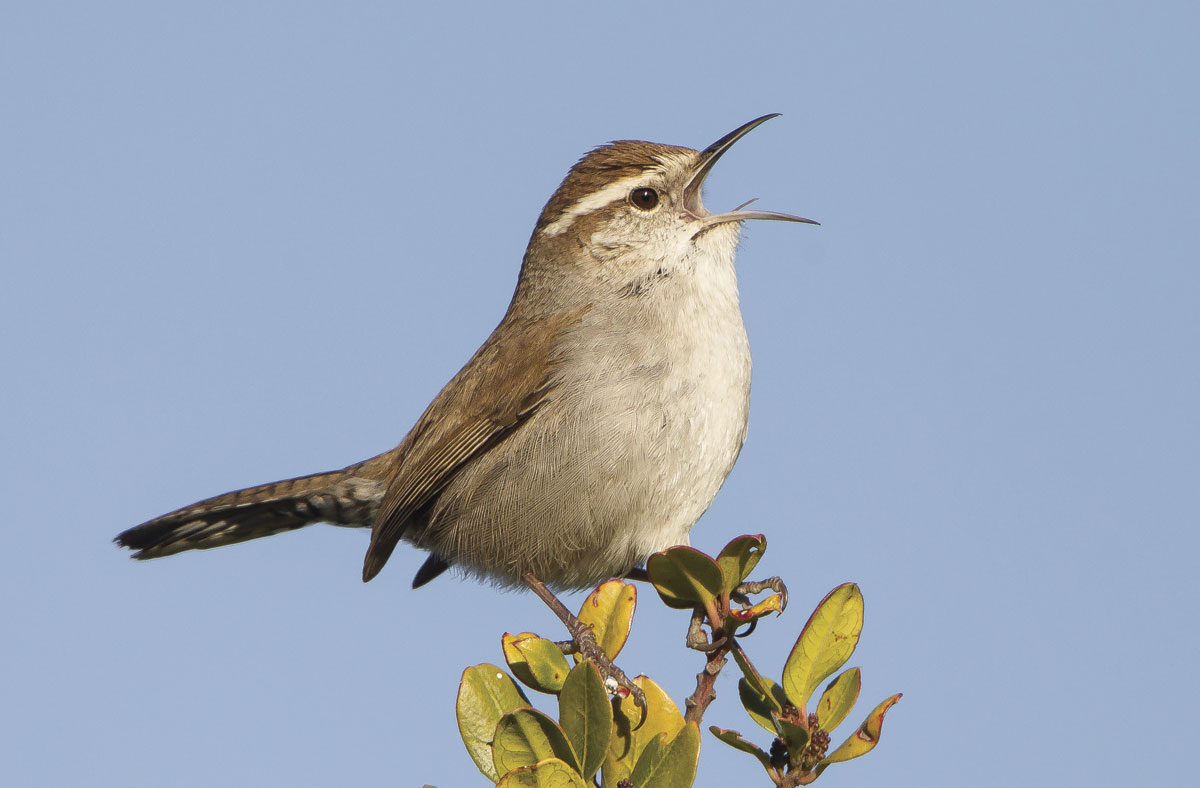
“Adorable” is how my wife, Susan, describes the Bewick’s wren. Brown on their backs, wings, tails, and heads, these slender wrens are gray on their bellies. The bill is curved, the tail is long and often upright, and the outer tail feathers show white. Its long, pronounced white “eyebrow,” or streak, helps easily distinguish the Bewick’s (Thryomanes bewickii) from the house wren (Troglodytes aedon), which it most resembles. Those eyebrows give it a cocky look, contributing to the “adorable” effect.
For such a small bird, the Bewick’s wren has tremendous vocal range and power—a male bird can sing up to 16 different songs. They are tireless, too—in early spring, a male can spend half his time singing. It’s no wonder a group of wrens is sometimes called a “chime”—or a flock, a flight, or a herd. On a recent bird walk in the Oakland Hills, local bird expert Bob Lewis said that when you hear a bird you can’t immediately identify by song, Bewick’s wren is often the right guess. I’m becoming more familiar with my resident male’s repertoire, but he’s still capable of fooling me.
The Bewick’s was formerly beloved as the familiar wren of the Appalachians and the Midwest, but the species today has almost disappeared completely east of the Mississippi. Ironically, competition from the house wren has, in part, led to its steep decline in the East and in parts of its traditional range in the western states.
The Bewick’s intrepid character echoes the Old High German alternate name for wrens, kuningilin, or “kinglet,” which is reflected in the fable of “The King of the Birds.” In a story that even Aristotle referenced, there was a contest among the birds to see who could fly the highest—the winner would be king. The eagle appeared to have beaten all the other birds but was tricked and bested by a wren that had hidden in the eagle’s plumage.
I observed the Bewick’s forward and inquisitive temperament last spring when I put up an old birdhouse on the side of our garden shed. Within minutes the Bewick’s was giving it a once-over. He was constantly moving about, getting a look at the birdhouse from different vantage points, wagging his tail feathers and cocking his brow at the vacant birdhouse.
This was the same birdhouse that a pair of Bewick’s had nested in several years earlier when it was in a different spot. Back then the structure was new and the wrens settled right in. The wrens’ family name is Troglodytidae, which comes from the word “troglodyte,” meaning cave-dweller—not only do some wren species forage in dark crevices, but many wren species are also cavity breeders, including four of the six species that live in the Bay Area. To the Bewick’s the birdhouse must have seemed like a dream home.
The male brought his mate to check out the new address and they built a nest together inside the birdhouse. Generally the female Bewick’s will start laying eggs one to three days after the nest is complete and will lay an egg a day until she has a clutch of five to six oval-shaped eggs that are white in color with spots that range from reddish brown to lilac or purple. Two weeks later the chicks begin to hatch.
When my pair’s chicks hatched, the female remained inside the birdhouse on the nest while the male brought food for her. Both the male and the female feed the chicks, which aren’t able to leave the nest for roughly two weeks. When they do leave, young birds can fly well enough to avoid ground predators (a good thing in our garden, since we have a cat and two Scottish terriers). Our fledglings avoided the resident pets and after about two weeks they moved off on their own.
Wrens are insectivores and their diet consists mainly of gleaned insects. In the 1930s and ’40s, noted UC Berkeley researcher Edwin Miller observed Bewick’s wrens feeding in Strawberry Canyon near the UC Berkeley campus. He concluded that the preferred habitat of the species was dense brush, both for the shelter it afforded and the forage it provided. Miller also noted that the western populations of Bewick’s wrens occurred in greater numbers away from human habitations.
From what I’ve observed, the Bewick’s has adapted nicely to living in our suburban “forests.” When the Bewick’s male made his appearance last spring, he announced himself immediately. Soon he was studying the old birdhouse in its new location. After a cursory inspection, he was off in the dense leaf cover of the weeping willow tree, seeing if it might be more suitable. He didn’t seem bothered by my presence, just choosy, even kingly, about his new house.




